An extremely unusual and exotic guest in your garden - the Negritenok tomato: we grow it ourselves and enjoy the harvest
Do you like exotic things? Tired of good old red, yellow and pink tomatoes? Do you want to diversify your country life and grow a vegetable with an unusual color to the envy of all your neighbors? Tomato Negritenok is what you need: its exotic appearance, sweet taste and aroma, ease of care will delight both you and your loved ones.
In our review, read the characteristics and description of the variety, cultivation features and techniques used by farmers to obtain a larger harvest.
Description of the variety
The tomato gets its name from its brown color. The Negritenok variety belongs to a variety of black-fruited tomatoes. The anthocyanin it contains gives the tomato an unusual color for these vegetables. However, it is not entirely true to talk about black tomatoes.
In fact, due to the purple pigment, tomatoes acquire the color of the fruit:
- from brown-green to brown-red-brown - the shade of both the skin and the pulp;
- blue-violet - only the skins, the flesh is red.
The variety was developed by breeding specialists from the Poisk agricultural company. The tomato was included in the State Register of the Russian Federation in 2010. The originators recommend growing it in open ground and greenhouses in all climatic zones of our country.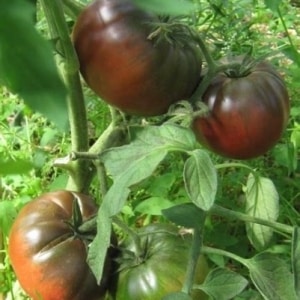
Distinctive features
Mid-season, indeterminate variety. Fruit ripening occurs at 110-115 days. The maximum height of the bush is 3.5 m. Medium leafy, the leaves are dark green, oblong, medium in size with a small fluff.The first inflorescence is formed after the 13th pair of leaves, on each raceme there are from 6 to 8 ovaries.
The roots of the plant do not go deep into the ground, they are located close to the surface, but grow in width.
Tomatoes tolerate temperatures down to +7 degrees.
Fruit characteristics, yield
From the description above and the photo it is clear that the fruits are dark brown in color. They acquire this color at the moment of biological ripeness; before that, green tomatoes have a dark brown-green spot at the stalk.
Other characteristics of tomatoes:
- flat-round shape;
- slight ribbing at the stalk (pronounced in large fruits);
- thick skin;
- juicy, medium-density red flesh;
- many chocolate-colored seeds (6 seed chambers);
- sweet and sour taste, tomato aroma;
- the weight of one fruit is from 150 (upper clusters) to 350 g (lower clusters).
The first fruits ripen 110-115 days after emergence. Productivity is low: from 1 sq. m, 6.5-8 kg are collected, on average - 1.5-2 kg of berries per bush.
How to grow seedlings
Sow seeds for seedlings 60-65 days before transplanting into the ground: in the first half of March.
Important! Check the expiration date of store-bought seeds (maximum 2-3 years). Seeds collected independently, on the contrary, take older ones - at least 2-3 years after collection.
Seed preparation
Before planting, prepare seed material to increase the germination of grains and the vitality of seedlings:
- Sort through the seeds: select seeds that are larger, smoother and not empty to the touch. Place them in a saline solution for 15-20 minutes (1 tablespoon of salt per glass of water). Select the grains that have sunk to the bottom.
- Warm up the seeds on a central heating radiator: place them on a cotton cloth on a radiator for 1.5-2 days.
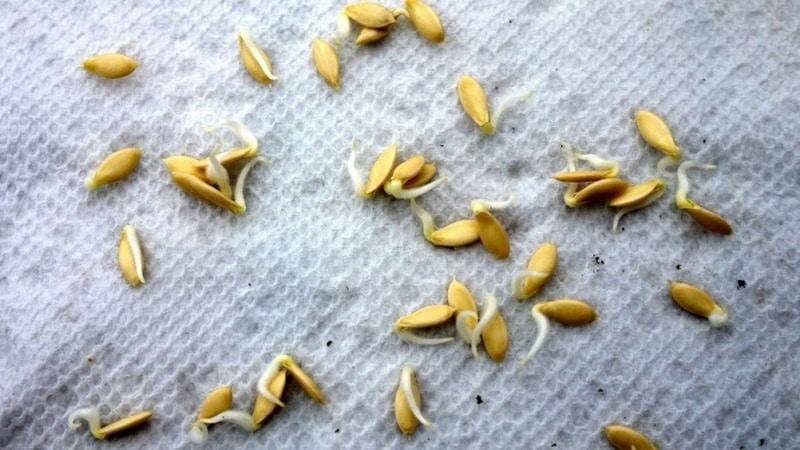
- Disinfect the grains with a 1% solution of potassium permanganate (1 teaspoon of potassium permanganate per 600 g of water) for 15-20 minutes. Be sure to rinse with clean water afterwards.
- Enrich the seeds with oxygen: place in warm water (+26+30 degrees) and stir every 60 minutes for 15-18 hours (if you have an aquarium compressor, use it).
- The seeds of many crops are protected by a thin film layer, which dissolves after a long stay in moist soil. Therefore, they require mechanical or hydraulic action to accelerate the germination process. Experts recommend a method using water and gas - bubbling. Oxygen helps accelerate seed germination, improves the development of seedlings and the growth of tomatoes.
- Soak the seeds in warm (+21 degrees) water or biostimulants (Zircon, Epine, Sodium Humate or liquid Energen).
- Harden the planting material: wrap the seeds in cotton cloth and plastic wrap and place them in a cool place with an air temperature of -3+2 (for example, in a refrigerator, on a balcony) for 8 hours. Then keep the seeds at room temperature for 8 hours. Repeat the procedure 5-6 times.
- Germination of grains. Moisten a cloth or gauze with warm water and place on a flat dish. Place the seeds, cover them with another layer of damp cloth and place them in a warm place. Keep the fabric damp at all times and wait for the embryos to appear. When they reach a size of 2-3 cm, plant them in the ground.
Container and soil
For seedlings, choose any convenient container: plastic cups, cut PET bottles, special containers. Before use, disinfect the container with a strong solution of potassium permanganate.
Buy a universal soil for tomatoes.It will definitely include:
- humus;
- river sand;
- peat or coconut substrate.
Or prepare the soil yourself by mixing:
- 1 part of garden land;
- 2 parts non-acidic peat (pH 6.5) or coconut substrate;
- 0.5 parts sand (river or washed);
- 1 part humus or sifted mature compost.
Add sifted wood ash or dolomite flour, sphagnum moss and fallen pine needles.
Pour boiling water or potassium permanganate solution over the finished mixture.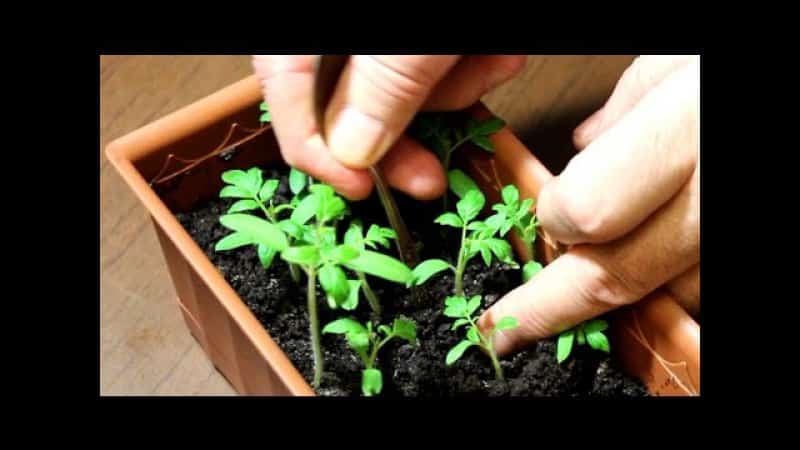
Sowing
Spread the seeds and sprinkle with a 5-7 mm layer of soil. Moisten the soil with a sprayer or spoon. Cover the containers with film and place in a warm (+24 degrees) place. When the shoots appear, lower the temperature: during the day to +12 – +15, at night to +8 – +10 degrees, remove the film and place the seedlings in a bright place. Provide the seedlings with 11 hours of daylight. If natural light is not enough, supplement the plants with fluorescent or LED lamps in the red or blue spectrum.
It is important to install lighting fixtures correctly. Correct the location of the light bulbs if:
- Burns appear on the leaves - increase the distance between the lamps and the plants.
- The leaves have become paler and the stem has become longer - bring the light source closer.
- The lamp is on the side and the stem is bent towards the light - place the lamps strictly above the plantings.
Growing and care
Pick up the plants in the phase of 4 true leaves, digging the seedlings down to the cotyledon leaves. Add mineral fertilizers to the soil for replanting (1 tbsp per 5 liters of soil mixture).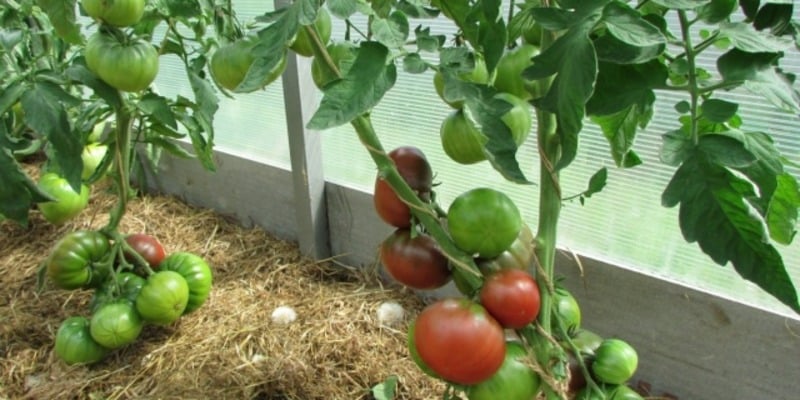
In 10-14 days feed with complex fertilizer. Repeat this every 2 weeks.
Water as the soil dries with warm water under the root, avoiding water getting on the castings and stem. Use a syringe or spoon for this.
Continue supplementary lighting if daylight hours are less than 12 hours.
Start hardening the seedlings 20 days in advance. In the first 5 days, take it out into the open air for 3-4 hours during the day. After that, add an hour a day. 4 days before moving, leave the seedlings overnight to acclimate them to night frosts.
How to grow tomatoes
Tomatoes are transplanted to a permanent location in May. At the beginning of the month - to greenhouses, in the middle-end – in open ground.
Landing
Before placing Negritenok tomato seedlings, prepare the area. Loosen the soil, remove weeds, apply organic and phosphorus fertilizers. A day before planting, treat the soil with a solution of potassium permanganate or boiling water to destroy possible infections or pest larvae.
Planting pattern – 40x60 cm. Plant tall seedlings at an angle, sprinkled with soil. This promotes the development of an additional root system and ensures better growth and development of the plant.
Care
Water the plants once every 7-10 days with warm water at the roots. With each watering, remove weeds and loosen the soil to ensure oxygen supply to the rhizome.
Before the first flowering, feed the tomatoes with ammonia fertilizer. During fruit formation, apply phosphorus fertilizer.
Form plants into 1-2 stems. Remove suckers and lower leaves regularly. Tie the tomatoes to a support and continue tying as the bush grows. Pinch the top when the bush reaches 2 meters in height.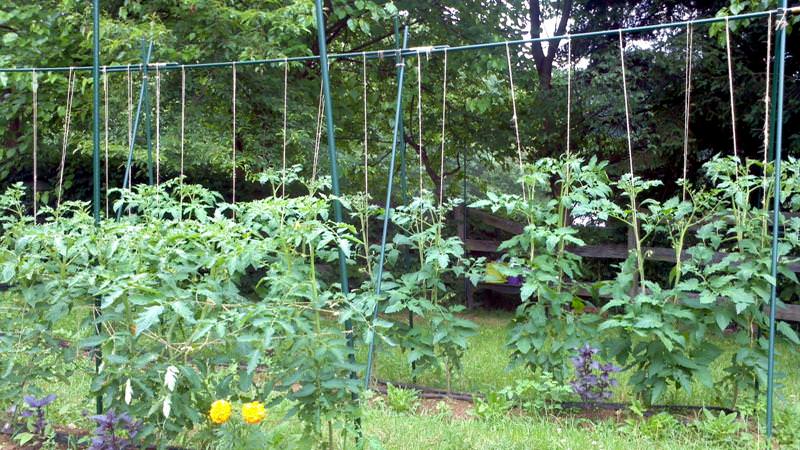
Features of cultivation and possible difficulties
Black-fruited tomatoes do not differ in care from red ones, and there are no difficulties in caring for them.
Tomatoes ripen unevenly, so as soon as the bunch has given up all the fruit, cut it off.
Diseases and pests
According to the originators, the variety is immune to common tomato diseases. To prevent fungal diseases in greenhouses, as well as in cool, rainy summers in open ground, treat plantings with Fitosporin.
Of the harmful insects, Negritok is attacked by terrestrial pests (Colorado beetles, whiteflies, slugs) and underground (chafer beetle larvae and wireworms).
Treat the plantings against the Colorado potato beetle with Prestige, against whiteflies with Confidor, and against slugs with the biological additive parasitic nematode.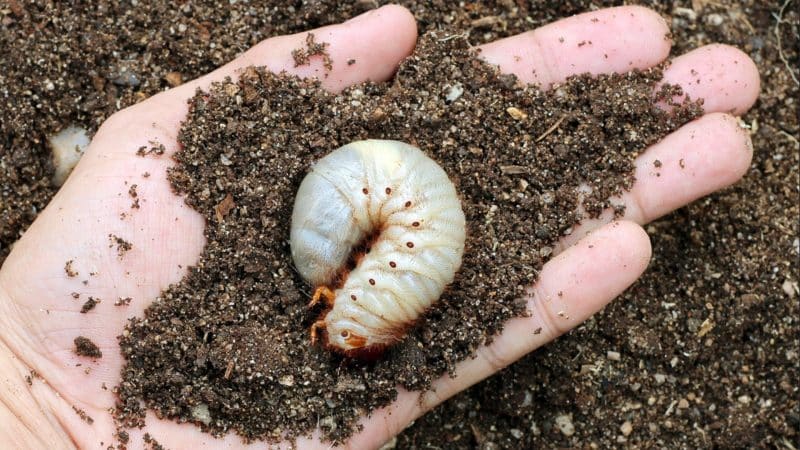
Important! Beetle poison will help against the Colorado potato beetle. Collect a liter jar of adults, pour into a 20 liter bucket and fill to the brim with water. After the beetles die (they sink to the bottom), infuse the poison for another week. Spray the tomatoes with a freshly prepared solution diluted with water (1:1, 1:2 - select the required proportion yourself). To prevent slugs, spray tomatoes with a solution of ammonia (dissolve 4 tablespoons of alcohol in a bucket of water).
Pre-planting soil treatment will help against underground pests: dig up the area in the fall, and the eggs will die from frost. The wireworm does not like calcareous soil, and the larvae of the cockchafer do not like soil rich in nitrogen. Mulch bushes with straw (sawdust, mown grass) soaked in nitrogen-containing fertilizers:
- urea;
- ammonium nitrate;
- old manure.
The nuances of growing in open ground and in a greenhouse
In the greenhouse, increase the distance between rows to 70 cm. Ventilate structures frequently.
When planting in open ground, check that the air temperature at night does not drop below +7 degrees. Tomatoes planted in cold soil or damaged are susceptible to root rot.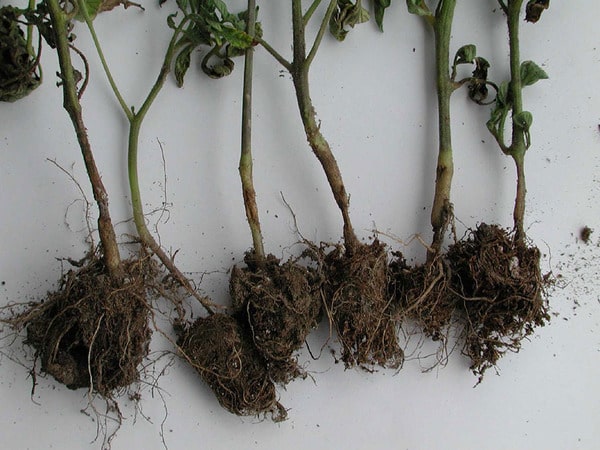
The photo shows that the disease affects the neck of the stem. Treatment is effective only at the beginning of the development of the disease, because the fungus quickly affects the entire bush and the plant dies. Even if you manage to cure the tomatoes, the bushes affected by rot will be stunted in growth and produce a low yield.
Harvesting and application
Tomatoes ripen in 110-115 days. If you follow the rules of agricultural technology, you will get from 6 to 8 kg of fruits per 1 square meter. m (3 bushes).
Use the fruits fresh and for preservation: lecho, adjika, ketchup and pickling in whole fruit form. Keeping quality is good: the fruits are stored for up to 1 month and do not lose their presentation during transportation.
Advantages and disadvantages of the variety
The advantage of the variety is the unusual color of the fruit. In addition, tomatoes:
- Long fruiting period.
- Good taste and aroma.
- Immunity to infections and diseases of tomatoes.
- There is no need for frequent watering.
- Possibility of long-term storage and transportation.
- Versatility of use.
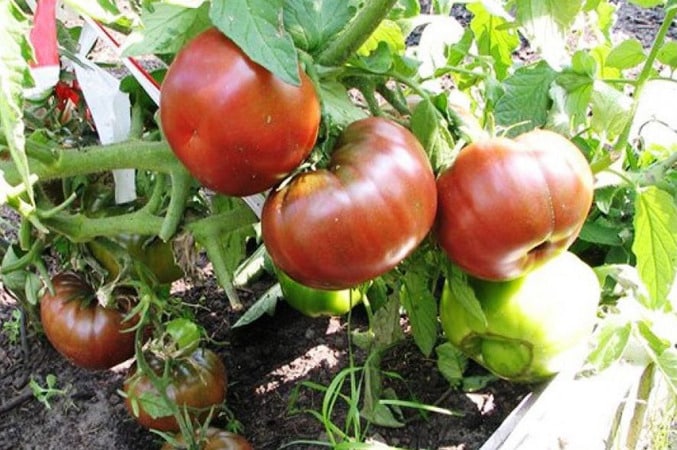
Important! The fruits have a high content of antioxidants, which promote accelerated cell recovery. They slow down the aging process and reduce the inflammatory response. Some scientists believe that antioxidants minimize the risk of cancer. The increased content of lycopene helps prevent heart and vascular diseases, atherosclerosis, and strengthen the immune system. Carotene improves vision.
The disadvantages of the variety include:
- the need for stepsons And garter bushes;
- crop instability;
- The tomato is not suitable for growing for sale.
Farmer reviews
Below we provide reviews from summer residents who have tried to grow Negritenok tomatoes on their plots. They note that they are planted not for a high yield, but to obtain unusual black fruits with a pleasant taste.
Igor Pankov, Krasnodar region: “I’ve been growing vegetables, it seems, all my life; in rural conditions it’s not difficult. There are tomatoes of different colors on the plot, among them the Negritenok tomato. The unusual coloring is emphasized by nearby yellow-fruited species. The tomato is tasty, not sour, and the first clusters ripen quickly. I have it growing in an open area. The variety does not like shade and drafts; it is best to determine the planting location on the south side behind the wall of the building.”
Svetlana Khramova, Voronezh region:
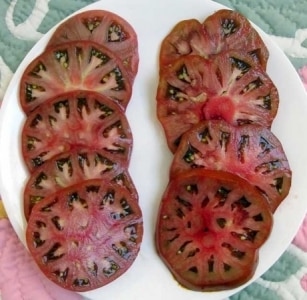
“I have been growing the Negritenok tomato variety for a long time; the priority is not high yield, but taste and unusual appearance. I plant tomato seedlings in the greenhouse in early May. When forming a future bush, I leave one stem at a time. They grow in a greenhouse until the night temperature reaches +10 °C, then I remove the film from the roof and sides. The trellis is solid – 2 m high. This is the end point of growth; at this level I break the top. When open, the tomatoes grow until September, then I cover the greenhouse again until frost.”
Nadezhda Sonina, Rostov region: “From 5 seeds 4 bushes grew, tall and strong. They were green all summer. I let them grow in one stem, shaped them, tied them up. But on the luxurious bushes only 4-5 tomatoes grew and ripened. Moreover, the first brush formed very late, only after the 14th leaf. The tomatoes were large, beautiful, very tasty, but so few! I liked their taste so much that I chose the seeds to sow next year. I will try again."
Olga Gradova, Kemerovo: “Negritenok’s seedlings were the most ordinary. Just stretched out a little. I planted them both in open ground and in a greenhouse, and they all started well.The bushes grew very powerful and beautiful, but they tied worse than other varieties. The first fruits were large and beautiful, then they became much smaller and remained green, they did not have time to ripen. They matured while lying in the room and even acquired brown spots. The harvest was average, but I’m glad about this, because it’s so nice to grow such exotic plants.”
Conclusion
Negritenok tomatoes are grown both in open beds and in greenhouses, but in shelter the bushes produce more fruit. Water the tomatoes once every 7-10 days, form them into 1-2 stems, and tie them to supports. The yield is not high (1.5-2 kg per bush), the weight of the fruit decreases towards the top (from 350 to 150 g). Summer residents put up with this because of the exotic color of the fruit, taste and greater health benefits compared to tomatoes of other colors.
Tomatoes are used both fresh and canned: as whole fruits, in snacks and sauces.